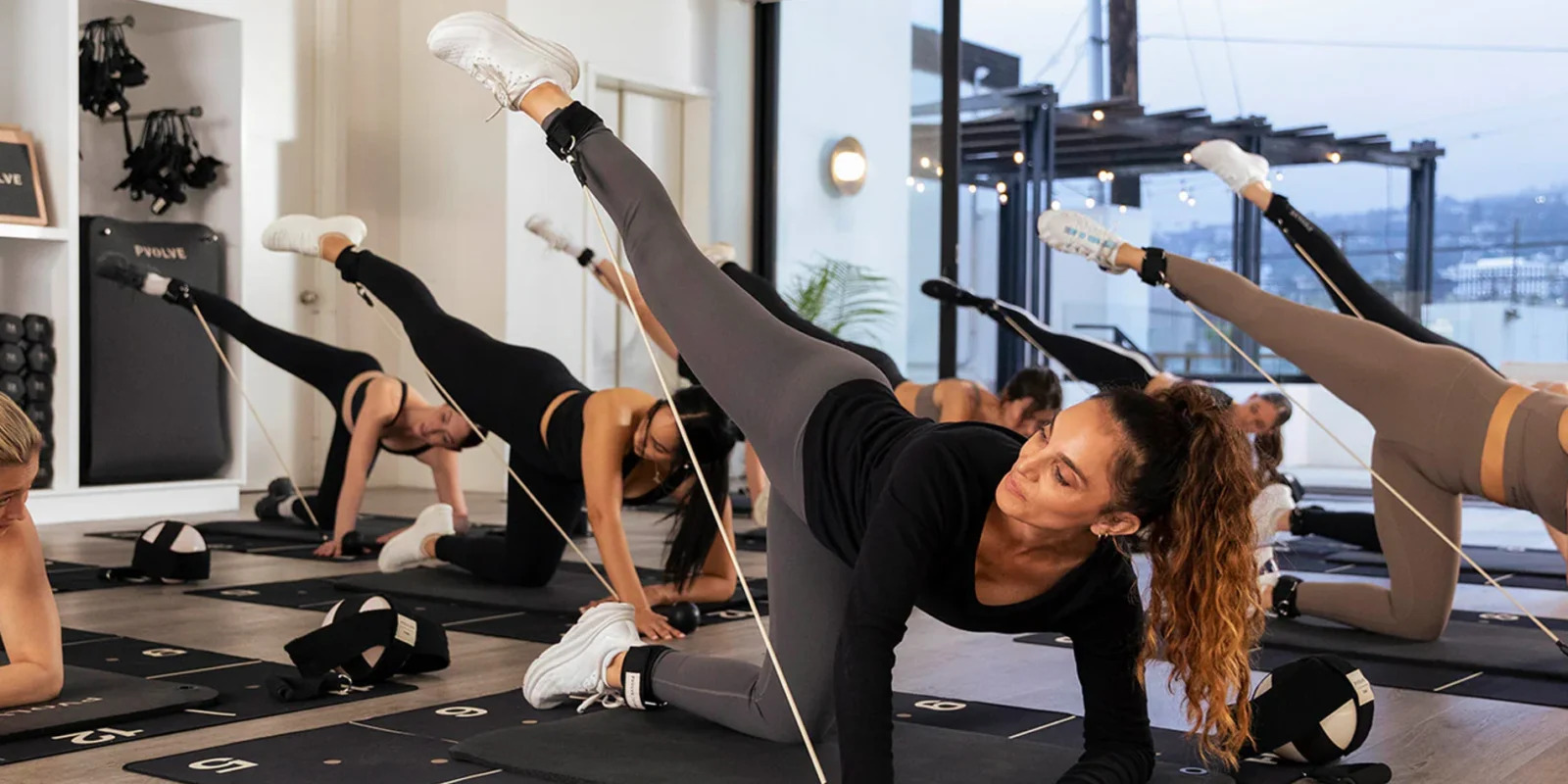Executives, medical experts and scientists from the biggest brands in fitness, wellness and wearables share how they’re working to make women’s health a bigger part of the conversation – and provide meaningful solutions
The women’s health industry is undergoing a seismic shift. After centuries of neglect, brands are finally tackling longstanding gaps in research and care. Leveraging scientific research, AI-driven insights and tailored fitness strategies, companies are addressing women’s physiological needs with data-driven solutions.
Overall, industry leaders agree that the future of women’s health will be defined by personalized solutions, increased research and greater awareness.
To learn more about the evolution of the women’s health space, Athletech News spoke with executives, medical experts and scientists from leading brands across fitness, wellness and wearables to uncover the key trends shaping women’s health in 2025 and beyond.
Pvolve Puts Women’s Health at the Heart of Its Fitness Programming
Pvolve is clear that it’s a fitness band for women first and foremost. The fast-growing functional fitness brand known for its partnership with Jennifer Aniston has been conducting clinical studies focused on women over 40 to demonstrate the Pvolve workout’s effectiveness in building muscle mass and improving mobility.
“We take a women-first approach, ensuring our programming serves women throughout their lifespan,” Pvolve president Julie Cartwright tells ATN. “We focus on healthy aging because we know that muscle loss accelerates in midlife. Our research ensures that our method delivers real, measurable results.”
Dr. Jessica Shepherd, a popular and well-regarded OB-GYN and advisor to Pvolve, highlighted how science-backed fitness is shaping women’s health and longevity.
“In 2025, we will see a stronger emphasis on exercise and resistance training as a preventative method, particularly for aging-related conditions such as osteoporosis, sarcopenia and metabolic health,” Dr. Shepard says. “Maintaining muscle mass is one of the most effective ways to support healthy aging, reduce the risk of chronic disease, and improve quality of life.”
Dr. Shepherd also underscored the importance of targeted exercise programs for women.
“Pvolve’s method is uniquely designed to work with, rather than against, hormonal changes,” she says. “Its resistance-based approach prioritizes strength, mobility, and stability, making it highly effective for women navigating menopause and perimenopause.”
Oura Expands Research in Female Health
Smart ring giant Oura is addressing the gaps in women’s health research through partnerships with leading institutions.
“Female health conditions receive just 1% of global healthcare research funding,” notes Dr. Neta Gotlieb, senior product manager, women’s health, at Oura. “We’ve launched a pregnancy study with Scripps Research to analyze biometric fluctuations throughout pregnancy, with the goal of identifying early warning signs for complications like postpartum depression and miscarriage.”
Beyond research, Oura is advancing AI-driven health tracking for women’s health.
“Our Cycle Insights feature provides detailed data on cycle phases, fertility signals and menstrual health,” says Dr. Gotlieb. “We’ve enhanced our Readiness Score algorithm to account for menstrual cycle fluctuations, reducing disproportionately low scores in the luteal phase by 81%.”
“The future of women’s health is about integrating data, research and technology to empower women with the insights they need to thrive,” she adds.
Whoop Eyes Data-Driven Coaching & Performance Insights
Whoop is taking a scientific approach to closing the gender gap in health research.
“We have our own playground for research at Whoop, and we have hundreds of thousands of women on our platform who are collecting and wearing data every single day,” says Kristen Holmes, global head of human performance and principal scientist at Whoop. “As a result, we’re able to start to really understand how women at a very basic level are responding and adapting to various types of exercise, their sleep needs and more.”
Whoop has uncovered key insights into how female physiology affects performance, sleep and recovery.
“Women in perimenopause experience twice the sleep fragmentation from alcohol as men,” Holmes reports.
Whoop’s research with West Virginia University also found that it could detect a pre-birth physiological marker seven weeks before delivery, an insight that could potentially help predict preterm labor. Whoop is integrating such findings into AI-powered coaching that offers women personalized training and recovery recommendations based on real-time biometric data.
Garmin Takes A Holistic Approach to Health Tracking
Garmin has also been tailoring its industry-leading wearable technology to better support women’s health.
“There is no one-size-fits-all solution to improving health and wellness, which is why our smartwatches provide insights that are tailored to each user,” says Susan Lyman, Garmin’s vice president of consumer sales and marketing. “That includes the Menstrual cycle tracking feature, personalized recovery insights, pregnancy tracking, support for menopause transition and more.”
Garmin is also leading advancements in sleep tracking for women.
“Studies show women need more sleep and are more likely to suffer from insomnia, which makes having accurate sleep data even more crucial when trying to improve physical and mental wellness,” Lyman explained. “Garmin smartwatches track different sleep stages, movement, breathing and more through the night, then provide users with a sleep score the next morning, along with recommendations for how to take on the day and prepare for even better sleep next time.”
Wild.AI Challenges the Status Quo in FemTech
Despite advancements, some feel that wearables are still missing key elements in their women’s health features.
Helene Guillaume, the founder and CEO of women’s health platform Wild.AI, believes leading wearables aren’t yet doing enough to empower women with meaningful insights.
“Pregnancy tracking is essentially just a countdown clock—no real-time insights or recommendations. … Sleep tracking doesn’t account for the reality that women wake up frequently during pregnancy and postpartum,” Guillaume tells ATN.
“Meanwhile, women in perimenopause get constant reminders that they ‘should’ have a period, and postpartum women receive period predictions that assume a 500-day cycle is normal,” she adds.
Guillaume stressed that the fundamental issue lies in the research gap, with much more medical research still being conducted on men than women.
“No research means no data, and AI-driven solutions are only as good as the data they’re trained on. Right now, tech wearables are actually widening the gap rather than closing it,” she says. “Longevity is framed as a ‘man’s word,’ but women are the original longevity champions. We live longer – so we should be studied to determine why and how those learnings can be applied to men.”
Breaking the Stigma Around Menopause
Menopause has historically been overlooked in the fitness and wellness industry, but it’s starting to receive long-overdue attention.
“In October, we released our first-ever Perimenopause Report that found the perimenopausal transition significantly disrupts restorative sleep while simultaneously increasing cardiovascular risk factors,” Oura’s Dr. Gotlieb notes. “We also launched a research study with Clue and UC Berkeley to better understand the impact of perimenopause on women’s health.”
Pvolve has also made menopause a priority in its fitness and wellness programming.
“Women deserve more resources for this life transition,” Cartwright says. “We’re committed to providing the education, movement and support they need.”
Dr. Shepard, who Pvolve brought on in February, is playing a key role on this front.
“Pvolve integrates targeted resistance training to combat muscle and bone loss, pelvic floor exercises to support core stability, and joint-friendly movements to ease menopause-related stiffness,” she says.
But Shepherd believes the fitness industry must evolve to support the full spectrum of hormonal health.
“We need to see a broader conversation around perimenopause and postmenopause—not just menopause itself,” she says. “By integrating clinical insights and structured movement, we can help women feel strong, confident and in control of their health through every phase,” she explained.
This article originally appeared in ATN’s 2025 State of the Industry Outlook Report, a go-to guide for understanding the next generation concepts that will shape the fitness and wellness industry in the upcoming decade. Download the free report.



